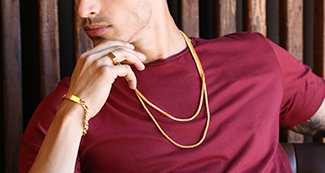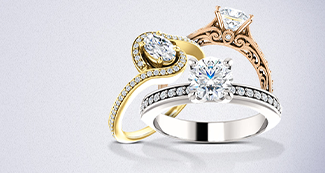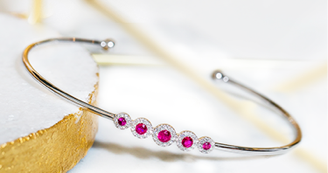Learn About Diamonds
THE 4 C’s of Diamonds
Diamond Cut
The first C in 4 C's of diamonds is the cut of a diamond which not only refers to the diamond’s shape, it also refers to how effectively the diamond returns light back to the viewer’s eye. A well-cut diamond will appear very brilliant and fiery, while a poorly cut diamond can appear dark and lifeless, regardless of its color or clarity.
Not only do well-cut diamonds appear more brilliant, they also tend to appear larger than other diamonds of the same carat weight. An "ideal" diamond has both increased brilliance and diameter relative to more deeply-cut diamonds.
Ideal cut diamonds
An Ideal Cut Diamond is a round, brilliant, or princess cut diamond that is cut to ideal proportions and angles, and has excellent polish and symmetry ratings. An Ideal Cut Diamond is perfectly proportioned to refract light, producing that fire and brilliance up through to the table and crown. Virani offers a nice selection of Ideal Cut Diamonds.
Diamond Color
When shopping for a diamond and trying to learn about diamonds keep in mind the second C in 4 C's of diamonds, it is generally preferred to choose a stone with the least amount of color possible. Diamond color is graded on a scale from D-Z and is divided into five broad categories (colorless, near colorless, faint, very light and light). Diamonds come in all colors of the spectrum. The predominant color you see in a diamond is yellow, which is caused by the trace element nitrogen. Generally, when comparing color between two diamonds, the diamonds need to be at least two color grades apart to even begin to see a difference. As you can see from the images below, when diamonds are in the face up position it is almost impossible to see any color. When viewing the diamond from the side profile, you may start to detect some color; however, diamonds are admired for their beauty from the face up position and not the side.

Diamond Clarity
Which Clarity Grade to Choose?
It is important to select a diamond that does not have any inclusions that will affect the overall beauty and durability of the diamond. The third C in the 4 C's of diamonds is important if you want to be 100% sure that your diamond will be completely clean of "eye-visible" inclusions, stick with diamonds graded "VS2" or higher. Shopping for SI quality diamonds can be very rewarding, but it's best to have those diamonds reviewed by Virani’s GIA team before finalizing your order. This will ensure you receive a diamond that does not have any inclusions visible to the naked eye.
It is also a good idea to balance the clarity grade of your diamond with the color. If you are looking at diamonds in the D-F color range, focus on clarity grades of VS2 or higher. Diamonds in the G-I color range combined with SI clarity are excellent values.
Diamond Carat
Lastly, the fourth C in 4 C's of diamonds is carat which is a term that refers to the weight of a diamond.
Which Carat Weight Is Right For You?
This question has no direct answer. It is a choice that depends on personal preference and budget. When looking at a diamond engagement ring, what is most visible is the size of the surface area on the top of the diamond. It is difficult to measure a diamond’s carat weight simply by looking at it. Although carat weight influences cost quite a bit, it is advisable to focus on diamond cut and diameter.
Diamond Shapes
Diamonds come in many different shapes. Each diamond shape possesses its own unique qualities, so exploring and learning about the various shapes is worth your while. James Allen offers the highest quality certified diamonds to satisfy all tastes.
Brilliant Cut Diamonds
The Round Diamond, or Brilliant Cut Diamond, is by far the most popular shape for diamond engagement rings. It is cone-shaped to maximize light return through the top of the diamond. It is cut to have 58 facets: 33 on the crown and 25 on the pavilion. The relationship between the angle of the crown (above the girdle) and the pavilion (below the girdle) is complementary. A steep crown angle is complemented by a shallower pavilion angle, and vice versa.
Cushion Cut Diamonds
The Cushion Cut Diamond is an antique cut that has a classic, romantic appeal. It is considered a cross between the Old Mine Cut, which was popular in the late 19th and early 20th centuries, and a modern Oval-Cut Diamond. The Old Mine Cut featured large facets and rounded corners, since the cutting was all done by hand at the time. They were designed to catch the beauty of candlelight. The Cushion-Cut Diamond contains 58 facets.
Marquise Diamonds
The Marquise-Cut Diamond is a boat-shaped brilliant stone that is considered to be a "classic" shape for diamond engagement rings. As with all 'fancy cut' diamonds, color and clarity are the two most important qualities in this particular style of cut. The Marquise-Cut Diamond uses a cutting process similar to that of a Round Brilliant Diamond, but the diamond cutter maximizes the carat weight of the gem by elongating it into its distinctive ''boat-shape''. This way, they can eliminate all inclusions while maintaining as much of the unblemished stone as possible. However, because of the elongated shape, color and clarity imperfections are more obvious than they are in a traditional Round Brilliant Diamonds.
Oval Diamonds
The Oval Cut Diamond is a modified version of the most popular cut, the Round Brilliant. It is the perfect choice for buyers who are looking for characteristics similar to the Round "Ideal" Cut, but would like something in a shape that is more unusual. Oval Cut diamonds also create the optical illusion of length and serve to elegantly elongate fingers.








 Contact Us
Contact Us